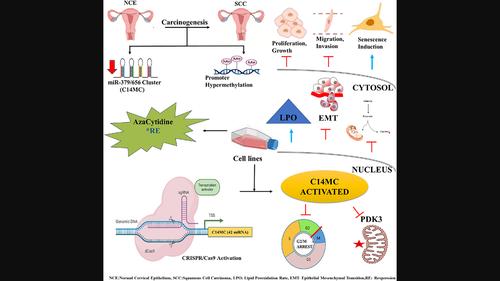当前位置:
X-MOL 学术
›
Mol. Oncol.
›
论文详情
Our official English website, www.x-mol.net, welcomes your feedback! (Note: you will need to create a separate account there.)
Regulation and tumor‐suppressive function of the miR‐379/miR‐656 (C14MC) cluster in cervical cancer
Molecular Oncology ( IF 6.6 ) Pub Date : 2024-02-24 , DOI: 10.1002/1878-0261.13611 Sriharikrishnaa Srinath 1 , Padacherri Vethil Jishnu 1 , Vinay Koshy Varghese 1 , Vaibhav Shukla 1 , Divya Adiga 1 , Sandeep Mallya 2 , Sanjiban Chakrabarty 1, 3 , Krishna Sharan 4 , Deeksha Pandey 5 , Aniruddha Chatterjee 6 , Shama Prasada Kabekkodu 1, 3
Molecular Oncology ( IF 6.6 ) Pub Date : 2024-02-24 , DOI: 10.1002/1878-0261.13611 Sriharikrishnaa Srinath 1 , Padacherri Vethil Jishnu 1 , Vinay Koshy Varghese 1 , Vaibhav Shukla 1 , Divya Adiga 1 , Sandeep Mallya 2 , Sanjiban Chakrabarty 1, 3 , Krishna Sharan 4 , Deeksha Pandey 5 , Aniruddha Chatterjee 6 , Shama Prasada Kabekkodu 1, 3
Affiliation

|
Cervical cancer (CC) is a key contributor to cancer‐related mortality in several countries. The identification of molecular markers and the underlying mechanism may help improve CC management. We studied the regulation and biological function of the chromosome 14 microRNA cluster (C14MC; miR‐379/miR‐656) in CC. Most C14MC members exhibited considerably lower expression in CC tissues and cell lines in The Cancer Genome Atlas (TCGA) cervical squamous cell carcinoma and endocervical adenocarcinoma patient cohorts. Bisulfite Sanger sequencing revealed hypermethylation of the C14MC promoter in CC tissues and cell lines. 5‐aza‐2 deoxy cytidine treatment reactivated expression of the C14MC members. We demonstrated that C14MC is a methylation‐regulated miRNA cluster via artificial methylation and luciferase reporter assays. C14MC downregulation correlated with poor overall survival and may promote metastasis. C14MC activation via the lentiviral‐based CRISPRa approach inhibited growth, proliferation, migration, and invasion; enhanced G2/M arrest; and induced senescence. Post‐transcriptional regulatory network analysis of C14MC transcriptomic data revealed enrichment of key cancer‐related pathways, such as metabolism, the cell cycle, and phosphatidylinositol 3‐kinase (PI3K)–AKT signaling. Reduced cell proliferation, growth, migration, invasion, and senescence correlated with the downregulation of active AKT , MYC , and cyclin E1 (CCNE1 ) and the overexpression of p16 , p21 , and p27 . We showed that C14MC miRNA activation increases reactive oxygen species (ROS) levels, intracellular Ca2+ levels, and lipid peroxidation rates, and inhibits epithelial–mesenchymal transition (EMT). C14MC targets pyruvate dehydrogenase kinase‐3 (PDK3 ) according to the luciferase reporter assay. PDK3 is overexpressed in CC and is inversely correlated with C14MC. Both miR‐494‐mimic transfection and C14MC activation inhibited PDK3 expression. Reduced glucose uptake and lactate production, and upregulation of PDK3 upon C14MC activation suggest the potential role of these proteins in metabolic reprogramming. Finally, we showed that C14MC activation may inhibit EMT signaling. Thus, C14MC is a tumor‐suppressive and methylation‐regulated miRNA cluster in CC. Reactivation of C14MC can be useful in the management of CC.
中文翻译:

miR-379/miR-656 (C14MC)簇在宫颈癌中的调控和抑癌功能
在一些国家,宫颈癌(CC)是导致癌症相关死亡的主要原因。分子标记及其潜在机制的鉴定可能有助于改善 CC 管理。我们研究了 14 号染色体 microRNA 簇(C14MC;miR-379/miR-656)在 CC 中的调控和生物学功能。大多数 C14MC 成员在癌症基因组图谱 (TCGA) 宫颈鳞状细胞癌和宫颈内膜腺癌患者队列的 CC 组织和细胞系中表现出相当低的表达。亚硫酸氢盐桑格测序揭示了 CC 组织和细胞系中 C14MC 启动子的高度甲基化。5-aza-2脱氧胞苷处理重新激活了C14MC成员的表达。我们通过人工甲基化和荧光素酶报告基因检测证明 C14MC 是甲基化调节的 miRNA 簇。C14MC 下调与较差的总体生存率相关,并可能促进转移。通过基于慢病毒的 CRISPRa 方法激活 C14MC 可抑制生长、增殖、迁移和侵袭;增强 G2/M 逮捕;并诱发衰老。C14MC 转录组数据的转录后调控网络分析揭示了关键癌症相关途径的富集,例如代谢、细胞周期和磷脂酰肌醇 3 激酶 (PI3K) –AKT 发信号。细胞增殖、生长、迁移、侵袭和衰老的减少与活性活性物质的下调相关AKT ,我的C ,和细胞周期蛋白 E1 (CCNE1 )和过度表达p16 ,p21 , 和p27 。我们发现 C14MC miRNA 激活会增加活性氧 (ROS) 水平、细胞内 Ca2+ 水平和脂质过氧化率,并抑制上皮-间质转化(EMT)。C14MC 靶向丙酮酸脱氢酶激酶-3(PDK3 )根据荧光素酶报告基因测定。PDK3 CC 中过表达,与 C14MC 呈负相关。miR-494-模拟转染和 C14MC 激活均受到抑制PDK3 表达。减少葡萄糖摄取和乳酸产生,并上调PDK3 C14MC 激活表明这些蛋白质在代谢重编程中的潜在作用。最后,我们发现 C14MC 激活可能会抑制 EMT 信号传导。因此,C14MC 是 CC 中的肿瘤抑制和甲基化调节 miRNA 簇。C14MC 的重新激活可用于 CC 的治疗。
更新日期:2024-02-24
中文翻译:

miR-379/miR-656 (C14MC)簇在宫颈癌中的调控和抑癌功能
在一些国家,宫颈癌(CC)是导致癌症相关死亡的主要原因。分子标记及其潜在机制的鉴定可能有助于改善 CC 管理。我们研究了 14 号染色体 microRNA 簇(C14MC;miR-379/miR-656)在 CC 中的调控和生物学功能。大多数 C14MC 成员在癌症基因组图谱 (TCGA) 宫颈鳞状细胞癌和宫颈内膜腺癌患者队列的 CC 组织和细胞系中表现出相当低的表达。亚硫酸氢盐桑格测序揭示了 CC 组织和细胞系中 C14MC 启动子的高度甲基化。5-aza-2脱氧胞苷处理重新激活了C14MC成员的表达。我们通过人工甲基化和荧光素酶报告基因检测证明 C14MC 是甲基化调节的 miRNA 簇。C14MC 下调与较差的总体生存率相关,并可能促进转移。通过基于慢病毒的 CRISPRa 方法激活 C14MC 可抑制生长、增殖、迁移和侵袭;增强 G2/M 逮捕;并诱发衰老。C14MC 转录组数据的转录后调控网络分析揭示了关键癌症相关途径的富集,例如代谢、细胞周期和磷脂酰肌醇 3 激酶 (PI3K) –



























 京公网安备 11010802027423号
京公网安备 11010802027423号